Evidence for multi-fragmentation and mass shedding of boulders on rubble-pile binary asteroid system (65803) Didymos
- PMID: 39080257
- PMCID: PMC11289111
- DOI: 10.1038/s41467-024-50148-9
Evidence for multi-fragmentation and mass shedding of boulders on rubble-pile binary asteroid system (65803) Didymos
Erratum in
-
Author Correction: Evidence for multi-fragmentation and mass shedding of boulders on rubble-pile binary asteroid system (65803) Didymos.Nat Commun. 2024 Nov 19;15(1):10021. doi: 10.1038/s41467-024-54185-2. Nat Commun. 2024. PMID: 39562790 Free PMC article. No abstract available.
Abstract
Asteroids smaller than 10 km are thought to be rubble piles formed from the reaccumulation of fragments produced in the catastrophic disruption of parent bodies. Ground-based observations reveal that some of these asteroids are today binary systems, in which a smaller secondary orbits a larger primary asteroid. However, how these asteroids became binary systems remains unclear. Here, we report the analysis of boulders on the surface of the stony asteroid (65803) Didymos and its moonlet, Dimorphos, from data collected by the NASA DART mission. The size-frequency distribution of boulders larger than 5 m on Dimorphos and larger than 22.8 m on Didymos confirms that both asteroids are piles of fragments produced in the catastrophic disruption of their progenitors. Dimorphos boulders smaller than 5 m have size best-fit by a Weibull distribution, which we attribute to a multi-phase fragmentation process either occurring during coalescence or during surface evolution. The density per km2 of Dimorphos boulders ≥1 m is 2.3x with respect to the one obtained for (101955) Bennu, while it is 3.0x with respect to (162173) Ryugu. Such values increase once Dimorphos boulders ≥5 m are compared with Bennu (3.5x), Ryugu (3.9x) and (25143) Itokawa (5.1x). This is of interest in the context of asteroid studies because it means that contrarily to the single bodies visited so far, binary systems might be affected by subsequential fragmentation processes that largely increase their block density per km2. Direct comparison between the surface distribution and shapes of the boulders on Didymos and Dimorphos suggest that the latter inherited its material from the former. This finding supports the hypothesis that some asteroid binary systems form through the spin up and mass shedding of a fraction of the primary asteroid.
© 2024. The Author(s).
Conflict of interest statement
The authors declare no competing interests.
Figures
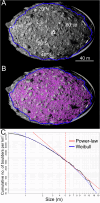

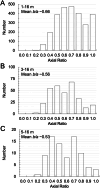
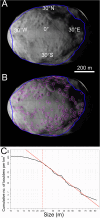
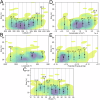

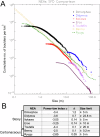

Similar articles
-
Mechanical properties of rubble pile asteroids (Dimorphos, Itokawa, Ryugu, and Bennu) through surface boulder morphological analysis.Nat Commun. 2024 Jul 30;15(1):6203. doi: 10.1038/s41467-024-50147-w. Nat Commun. 2024. PMID: 39079972 Free PMC article.
-
The geology and evolution of the Near-Earth binary asteroid system (65803) Didymos.Nat Commun. 2024 Jul 30;15(1):6202. doi: 10.1038/s41467-024-50146-x. Nat Commun. 2024. PMID: 39080262 Free PMC article.
-
Fast boulder fracturing by thermal fatigue detected on stony asteroids.Nat Commun. 2024 Jul 30;15(1):6206. doi: 10.1038/s41467-024-50145-y. Nat Commun. 2024. PMID: 39080275 Free PMC article.
-
Exploring the Bimodal Solar System via Sample Return from the Main Asteroid Belt: The Case for Revisiting Ceres.Space Sci Rev. 2020;216(4):59. doi: 10.1007/s11214-020-00671-0. Epub 2020 May 18. Space Sci Rev. 2020. PMID: 32624627 Free PMC article. Review.
-
Organic Matter in the Asteroid Ryugu: What We Know So Far.Life (Basel). 2023 Jun 26;13(7):1448. doi: 10.3390/life13071448. Life (Basel). 2023. PMID: 37511823 Free PMC article. Review.
Cited by
-
Mechanical properties of rubble pile asteroids (Dimorphos, Itokawa, Ryugu, and Bennu) through surface boulder morphological analysis.Nat Commun. 2024 Jul 30;15(1):6203. doi: 10.1038/s41467-024-50147-w. Nat Commun. 2024. PMID: 39079972 Free PMC article.
-
The WheelCams on the IDEFIX rover.Prog Earth Planet Sci. 2025;12(1):54. doi: 10.1186/s40645-025-00725-3. Epub 2025 Jul 14. Prog Earth Planet Sci. 2025. PMID: 40672784 Free PMC article.
-
The geology and evolution of the Near-Earth binary asteroid system (65803) Didymos.Nat Commun. 2024 Jul 30;15(1):6202. doi: 10.1038/s41467-024-50146-x. Nat Commun. 2024. PMID: 39080262 Free PMC article.
-
Fast boulder fracturing by thermal fatigue detected on stony asteroids.Nat Commun. 2024 Jul 30;15(1):6206. doi: 10.1038/s41467-024-50145-y. Nat Commun. 2024. PMID: 39080275 Free PMC article.
-
Diverse evolutionary pathways of spheroidal asteroids driven by rotation rate.Sci Rep. 2025 Apr 7;15(1):10284. doi: 10.1038/s41598-025-94574-1. Sci Rep. 2025. PMID: 40195388 Free PMC article.
References
-
- Harris, A. W., Fahnestock, E. G. & Pravec, P. On the shapes and spins of “rubble pile” asteroids. Icarus199, 310–318 (2009).
-
- Melosh, H. J. & Ryan, E. V. Asteroids: shattered but not dispersed. Icarus129, 562–564 (1997).
-
- Benz, W. & Asphaug, E. Catastrophic disruptions revisited. Icarus142, 5–20 (1999).
-
- Campo Bagatin, A., Petit, J. M. & Farinella, P. How many rubble piles are in the asteroid belt? Icarus149, 198–209 (2001).
-
- Davis, D. R., Durda, D. D., Marzari, F., Campo Bagatin, A. & Gil-Hutton, R. Collisional evolution of small-body populations. Asteroid III Ch4, 545–558 (2002).
LinkOut - more resources
Full Text Sources

